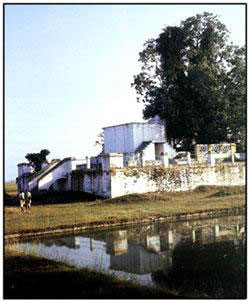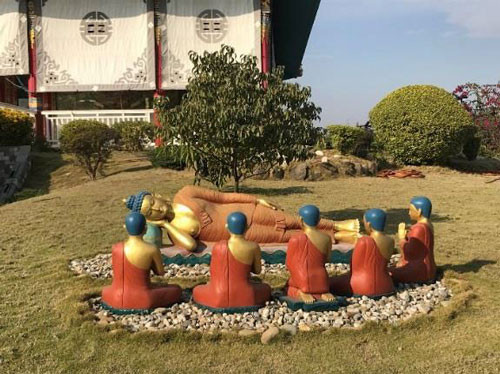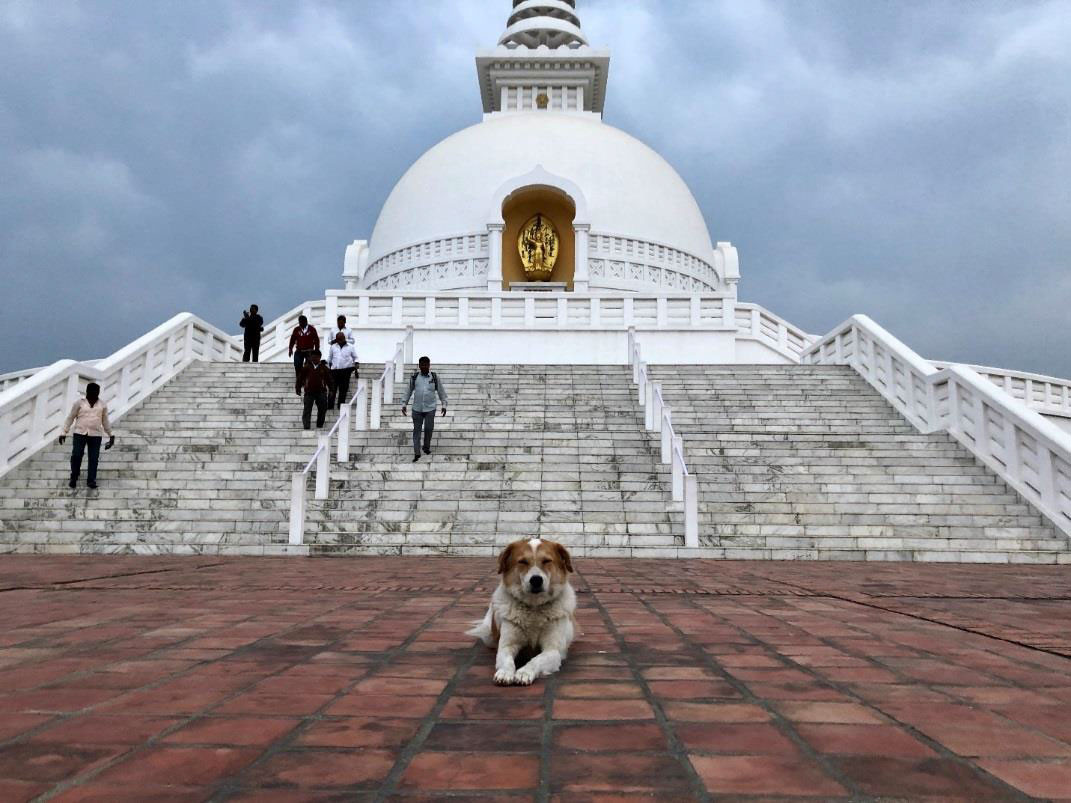Lumbini: A Diamond in the Rough

I had visited the birthplace of Lord Buddha with a group of college friends. It was end of summer, right before Dashain. It was still stiflingly hot and dusty in Lumbini. Eighteen of us filed into two already over capacity public mini vans with broken windows, almost sitting on top of each other, to travel the hour drive from Bhairahawa to Lumbini. It felt like hours on the bumpy dirt road to reach what we hoped would be a sight for our sore eyes.
We reached there in one piece; but our disappointment was tangible. The whole area was dry, deserted, abandoned, and unimpressive. There was nothing to show that this was a precious piece of our heritage, let alone a site for pilgrimage.
The only structures at the time, almost in the middle of nowhere (or so it seemed), was an old dilapidated white (Mayadevi) temple with the precariously inclined Ashoka pillar next to it, and a monastery, the Dharma Swami Maharaja Buddha Vihar. The unkempt pond was to the south of the temple with the Bodhi tree on the other side of the pond. This pond is the sacred Puskarini where Queen Mahamaya bathed before giving birth to her godly child, Prince Siddhartha Gautam in 623 BCE. This is also the same body of water in which the newly born child had his first purification bath. According to ancient Buddhist texts, the Bodhi tree is a descendant of the original Bodhi trees that Lord Buddha would later meditate under. The famous Sal tree was to the east, in close proximity of the temple. Historical literature tells us that this tree was also a descendant of the one that Queen Mahamaya held on to while she was giving birth to her famous child .
.
The Dharma Swami Maharaja Buddha Vihar was the only place we truly felt the presence of peace in all of Lumbini. This Tibetan styled Gompa, consisting of an impressive larger than life statue of Lord Buddha, was built by His Eminence Chogya Trichen Ringboche and Raja of Mustang. We were told Tara Puja was conducted there every day by the monks that resided there. It was serene, cool, and quiet.
History has it that Mayadevi temple was built in the 1930s by Kaisar Shamsher JB Rana, the 3rd son of the then Prime Minister of Nepal, Chandra Shamsher JB Rana. To his credit he took the initiative to excavate the area where it was believed Lord Buddha was born, widened the sacred Puskarini and built this temple on a platform around a Nativity sculptor. The sculptor depicts Queen Mayadevi holding on to a tree branch with her right hand and a newly born Prince Siddharth standing on lotus flowers. It is unclear if this sculptor was part of the relics discovered during his excavations. If it was, then this could be the sculptor commissioned by King Ashoka when he established his pillar in the 3rd century BCE.
The Ashoka pillar gives credence to Lumbini as Lord Buddha’s birthplace. Emperor Ashoka of India, grandson of Chandragupta Maurya, visited Lumbini in search of solace, to repent all the wars and bloodshed that he had inflicted. He erected a sandstone pillar (stambha) in 249 BCE with 5 lines and 90 words inscribed in Bramhi script and Pali language. He also placed a commemorative stone on the exact spot where Prince Siddhartha Gautam first touched the earth after birth.
On the uppermost portion of the east face of the pillar another inscription was placed by Ripu Malla, a Prince of the Nagaraja dynasty of western Nepal, in the 14th century CE. Since then the pillar and birthplace of Buddha was apparently lost to society until the area was rediscovered in 1896 by General Khadga Shamsher Rana, the Governer of Palpa, and German indologist/archaeologist Anton Führer.
Lumbini Visit 2019
January 2019 was when I visited Lumbini again. The experience was different, almost surreal. The weather was almost perfect, comfortable during the day and crisp and a little chilly early mornings and evenings. Buddha Air flies to Bhairahawa - then it is an hour’s drive on smooth paved roads to Lumbini. Alternatively the drive from Kathmandu is about 7-8 hours on largely comfortable, well-maintained, paved roads except for a short distance immediately after exiting Kathmandu (what could be 10 minutes at this juncture can take an hour). We decided to travel via our Scorpio the whole way experiencing local Nepali conversations and meals along the way, following the beautiful Trishuli and Marsyangdi rivers which eventually fall into the massive Narayani.

A warning here that this snaking hilly road can be blocked during monsoon with inevitable landslides causing excruciatingly long delays.The sun had just set when we reached Lumbini. The dirt roads began. We assumed, somewhat optimistically, that the roads were being widened and built. There were large pot holes that we had to maneuver around. Our destination was Hotel Kasai. Somewhat lost, we ended up driving the perimeter of the fenced area housing the Sacred Garden and Monastic Zones, eventually asking our way to the hotel. We saw several hotels dotting the landscape east side along the perimeter road.
It was 6 pm. We were told the doors to Mayadevi Temple closed at 7 pm. We hurried to Gate 5 (out of 9 gates along the boundary of the Lumbini Master Plan Area) parked our v ehicle outside and walked the half mile road in the dark to the temple. Drivers were beckoning us to their 3-wheeler taxis, claiming there were wild boars and monkeys hiding in the dark woods. I admit I was a little nervous but we were determined to walk after being cramped in a vehicle all day. It was pitch black in places but the brisk walk was energizing. The cool ambience felt peaceful already. Meeting friendly people along the way, we bought tickets and entered the grounds of the Sacred Garden after taking off our shoes. The splendor of the beautifully lit temple and Pushkarini, the holy pond, is best visualized after dark. It hit me that I was standing on the very grounds Lord Buddha was born over 2500 years ago. I felt both amazed and humbled sitting on the steps of the pond where he received his first bath. The Bodhi tree was well lit with Buddhist flags decorating its branches.
ehicle outside and walked the half mile road in the dark to the temple. Drivers were beckoning us to their 3-wheeler taxis, claiming there were wild boars and monkeys hiding in the dark woods. I admit I was a little nervous but we were determined to walk after being cramped in a vehicle all day. It was pitch black in places but the brisk walk was energizing. The cool ambience felt peaceful already. Meeting friendly people along the way, we bought tickets and entered the grounds of the Sacred Garden after taking off our shoes. The splendor of the beautifully lit temple and Pushkarini, the holy pond, is best visualized after dark. It hit me that I was standing on the very grounds Lord Buddha was born over 2500 years ago. I felt both amazed and humbled sitting on the steps of the pond where he received his first bath. The Bodhi tree was well lit with Buddhist flags decorating its branches.
Inside Mayadevi Temple there was a heavy police presence to protect the ancient relics and stones. Photography was not allowed. It was with a feeling of wonder that I walked on the raised platform encircling the structural ruins, representing various models of reconstruction of the temple over different eras dating back to the 6th century BCE, to view the Nativity Sculptor in the middle of the temple. This iteration of the Temple is a beautiful steel and brick structure established in 2002 by the joint efforts of the Japanese Buddhist Foundation and Lumbini Development Trust to protect the archaeological treasures. The final excavations of 1990s also uncovered the Marker Stone, most likely from Ashoka (Mauryan) era in 249 BCE, which is sealed under a bulletproof glass casing.
 We strolled, somewhat awestruck, around the ancient ruins of the several stupas and viharas, remains of ancient shrines and monasteries dating back several centuries, within the sacred garden, south of Mayadevi temple. The latest effort to unearth the archeological treasures and beautify Lumbini started when the then United Nations Secretary-General Mr. U Thant met with the Late King Mahendra Bir Bikram Shah after his visit to Nepal in 1967. A Master Plan was created by Japanese Architect Kenzo Tange in 1978. Lumbini became a UNESCO World Heritage Site in 1997.
We strolled, somewhat awestruck, around the ancient ruins of the several stupas and viharas, remains of ancient shrines and monasteries dating back several centuries, within the sacred garden, south of Mayadevi temple. The latest effort to unearth the archeological treasures and beautify Lumbini started when the then United Nations Secretary-General Mr. U Thant met with the Late King Mahendra Bir Bikram Shah after his visit to Nepal in 1967. A Master Plan was created by Japanese Architect Kenzo Tange in 1978. Lumbini became a UNESCO World Heritage Site in 1997.
The next morning after breakfast we ventured out into the East Monastic Zone. The Master Plan of the entire area (1 mile x 3 miles) is displayed outside Gate 5. We entered through Gate 1, bought tickets and started walking towards the various monasteries. Again there were 3- wheeler taxis beckoning tourists. Visitors can hire one of these at a very reasonable cost and drive and visit any or all the monasteries. The single lane road was dusty but the weather was cool. We decided to walk.
Our plan was to visit the monasteries within the East Monastic Zone that day and tour the West Monastic Zone which was across the central canal, the next day. We started with the stunning Royal Thai Buddhist Monastery built with gleaming white marble. The others had their own structure and beauty: Canadian Bodhi Institute Monastery and Dharma Center, Mahabodhi Society Temple of India, Cambodian Temple, Myanmar Golden Temple, Sri Lankan Monastery, and Dhamma Janani Vipassana Center, Nepal.

At the end of the day, we took a motor-boat and traversed the length of the Central Canal to reach the north gate. The Central Canal is a 1.4 Km (0.8 miles) long body of water lined on either side by wide brick-paved pedestrian paths with trees. We could see that it stretches from the Sacred Garden on the south, straight in line with the Ashoka pillar, continuing on to the eternal World Peace Flame to end at the north gate on the other side of the Monastic zones. Visitors were taking pictures of the Eternal Peace Flame that was ignited in November 1986 by a flame brought all the way from the United Nations in New York City to commemorate the International Year of Peace. There were visitors and pilgrims alike, sitting, walking, and even on boats on the canal, soaking the peace and the presence of Lord Buddha.

The 3rd day we walked around the West Monastic Zone. Again there were over 18 (4 under construction) strikingly beautiful monasteries erected by various nations reflecting the architectural and religious styles of the respective nations. We visited all that we were allowed to walk into. Each was unique including Singapore, China, France, Japan, Canada, Vietnam, Austria, South Korea, Laddakh, Myanmar, and several by Nepal. However the most striking was the Great Lotus Stupa, sponsored by Germany. The complete life story of Lord Buddha is depicted by several larger-than-life size statues surrounding the monastery within the beautiful compound of this magnificent Stupa.
We could not conclude our visit to the sacred birthplace of Lord Buddha without experiencing the Peace Pagoda. This serene, gleaming- white stupa towering into the evening skies was built in 2001 by the Nipponzan-Myōhōji Buddhist Order. This is one of several Peace Pagodas built around the world as shrines to world peace.
Climbing the marble stairs to view the brightly lit giant statues of Lord Buddha with the chanting of the monks in the background was surreal and an apt ending to our visit to the birthplace of the symbol of peace and harmony, Lord Buddha.
